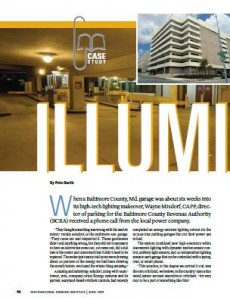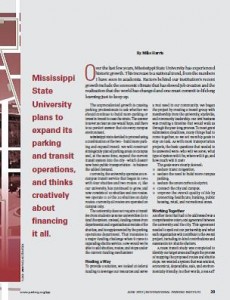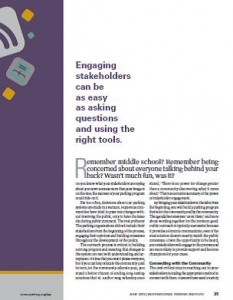When a Baltimore County, Md. garage was about six weeks into its high-tech lighting makeover, Wayne Mixdorf, CAPP, director of parking for the Baltimore County Revenue Authority (BCRA) received a phone call from the local power company.
“They thought something was wrong with the electric meter,” recalls Mixdorf, of the Baltimore Ave. garage. “They came out and inspected it. Those gentlemen didn’t find anything wrong, but they still felt it necessary to have an electrician come out. He came out, did a full test of the meter and confirmed that it didn’t need to be replaced. The meter just clearly told us we were drawing about 50 percent of the energy we had been drawing the month before. We found the whole thing amusing.”
Amusing and satisfying: Mixdorf, along with Manitowoc, Wis., company Orion Energy Systems and its partner, Maryland-based Pritchett Controls, had recently completed an energy-efficient lighting retrofit for the BCRA’s four parking garages that cut their power use in half.
The system combined new high-efficiency white fluorescent lighting with dynamic motion sensor control, ambient light sensors, and 40 independent lighting zones in each garage that can be controlled with a laptop, iPad, or smart phone.
“This solution, to the degree we carried it out, was the first of its kind, we believe, in the country,” says Brian Wolff, senior account executive at Pritchett. “It’s very cool to be a part of something like this.”
It was also environmentally friendly and fiscally smart. According to the Baltimore Sun, the project’s cost of $875,000 was supported by a $150,000 U.S. Department of Energy grant and more than $150,000 in rebates from utility provider Baltimore Gas and Electric (BGE). Return on investment should take place between three and four years, and with an energy reduction of between 60 and 75 percent, BCRA can expect to save an estimated $235,729 per year.
Additionally, because of the reduction in energy consumption, carbon dioxide emissions will be reduced by 1,225 tons annually, according to the Environmental Protection Agency.
How it Works
Each of the BCRA’s four garages has between 825 and 950 parking spaces, for a total of 3,462. There are 160 total lighting zones (40 at each site), all of which can be controlled independently in ways and to degrees Mixdorf didn’t expect.
“When I first envisioned the project, I thought I could control the lights in each garage from my desktop at my office (in the basement of the one of the garages),” he says. “I thought I might be able to have a setup where I could get an IP address and do it from my laptop at home. But I never envisioned the ability to do it with a smart phone or iPad. This just gives me such a tremendous amount of flexibility and far more control than I anticipated.”
When Mixdorf started as director of parking for BCRA in 2008, he was stunned to discover that all of the lights at the four garages were turned off at different times during the night (depending on the use of each garage), and not turned on again until 6 a.m.
“They were either all on or all off,” he says. “We had garages that, late at night, were completely dark. Those were terribly unsafe conditions. The first thing I did was turn the lights back on and leave them on all the time. That wasn’t great either but those were our only choices at the time.”
Mixdorf’s lights-on approach led to a steady stream of complaints from neighbors, who had lights shining into their apartments or condos deep into the night. With a new, 20-floor apartment building under construction across the street, Mixdorf knew something had to change.
“We want to be good neighbors,” he says. “What we have now and what we’ll have moving forward is lighting that, first, will not be on 100 percent of the time (because of the motion sensors) and second, will be dimmed to 60 percent at times and be much less intrusive. Wolff adds, “If Wayne gets a complaint, he can either dim or shut down specific zones without shutting off the whole lighting system.”
Mixdorf’s voice rises with excitement when he talks about the benefits of this project. Some of the rewards—reduced energy costs and cleaner-looking lighting—he expected when the first fixture was installed in July 2011. But the fringe benefits have continued to pleasantly surprise him.
Beyond the Obvious
“I never anticipated the ability to monitor the power consumption on an hourly basis,” he says. “I can work with the local power company much more closely in what they call their peak rewards program, to dial back power usage at its heaviest times.”
With this advanced technology at his fingertips, Mixdorf can make better-informed security guard shift decisions based on motion sensor readings that indicate car and human traffic in the garages.
Another benefit involves much easier replacement of the traffic signs that guide customers through the garages. Before, special signs that reflected yellow light correctly had to be purchased.
“Now we can use any sign, because all signs look good with white light.”
“This is a project that can be replicated in any parking garage,” Mixdorf says.
“Most parking garages have been built with either metal halide lighting or high-pressure sodium lighting, both of which are high-energy draws. For a relatively small amount of money, you can change from a situation that cost, in our case, $300,000 a year, to cutting that cost in half.”
Nate Pritchett, project manager for the BCRA garage retrofit, says it’s “an exciting time to be in the energy business.”
“Jobs like this one have such a tangible reward for all of us, from dollars saved to reduction of (environmental) impact,” he adds. “It’s very rewarding. I wish more people would think the way the Revenue Authority does. Half the battle is having a forward-thinking client who is willing to look at current practices and say, ‘You know what, I think we can do better.’ That’s what happened in this case. It was a blast.”
Pete Barth is senior writer with Orion Energy Systems. He can be reached at pbarth@oesx.com or 920.482.5915









